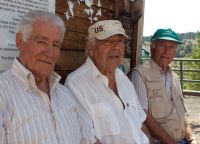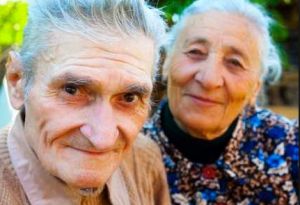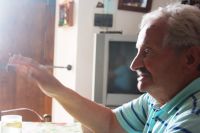Dialect of Calascio
WHAT IS A DIALECT?
A dialect is defined when speakers of two different language forms understand each other despite the fact their language differences cause minimal problems in communicating. Additionally, dialect speakers can have differing accents as well as differing grammar and/or vocabulary but they are not speaking a different language. According to Edward J. Vajda, a historical linguist at Western Washington University, “the main difference between dialect and language is part linguistic and part opinion based on… politics or culture.”

Antonacci, Roscetti & Iocca, Calascio 2013. Photo credit, Calascio.com
1861 to the 1960s
Prior to Italy’s unification in 1861 there was no unified scholastic system or a unified political structure. Italy was comprised of fiefdoms, duchies and the Papal States and in Abruzzo, the region was ruled by kingdoms under Spain and then France during the reign of Napoleon Bonaparte. Without political unification and the long influx of foreign rule coupled with a lack of education, Italian dialects were not only native to Italy they were preserved. Dialect was also born out of isolationism when travel from town-to-town was arduous and dangerous. Lack of communication with other Italians helped contribute to regional and local Italian dialects.
After unification, dialect remained the dominant linguistic communication between Italians of the working class, the rural population and urban areas. Conversely, Italians of privileged rank took advantage of formal education enabling them to speak grammatically correct. After Italy’s first nationwide census in 1871, statistics pointed to significant illiteracy rates. In reaction, a nation-wide education initiative became top concern and what followed was the slow move away from church-based schooling to state-sponsored education.
During the period when the Fascist Party was in power (1922-1943) the government created a comprehensive educational system that began in the elementary grades and finished at the university level. The government also increased the compulsory age of education from 11 years of age to 14 years. In spite of these advances, it was not until the post-WWII era when more access to higher education coupled with widespread television programming, helped standardize the Italian language. As Italian society became increasingly educated, dialect use after WWII became associated with a form of low socio-economic status. Changes to the scholastic system in the early 1960s ensured that more children had an opportunity to attend school. As a result, dialect usage was eliminated from the generations of Italians growing-up in the post-WWII era.
Abruzzese Dialect
Italian dialect is divided into four subgroups: the northern, the central, the upper southern and the lower southern. Dialect of the Abruzzo region is often classified as upper southern. Linguistically, Abruzzo has two dialectal zones: L’Aquila province with central Italian characteristics in its dialect and Teramo, Pescara and Chieti provinces with southern Italian dialectal characteristics. Depending on the province, dialects originating in the same area may have different characteristics in phonetics and syntax.

Photo courtesy of www.worldimmigration.it
CALASCINO
The dialect of Calascio is termed Calascino and it is a microvariation of the Abruzzo dialect of L’Aquila province. Calascino has grammatical rules and those rules change depending on the speaker’s age if the are a native (born in Calascio). In 2013, Calascio.com took an informal sample of dialect use between seven female and seven male citizens born and living Calascio. All fourteen natives could speak and communicate in Calascino and each was born before 1948. Calascio.com further discovered that Calascino speakers born outside of Italy before 1948 in the European Community, in the United States, or in Canada to parents who spoke Calascino at home tended to use an older and differing set of pronouns than the fourteen speakers sampled in Calascio proper. The pronoun usage difference could be attributed to isolationism whereby retention of an older, pre-WWII Calascino remains stronger among speakers living outside the village.
Pronoun differences are noted below. Calascio.com thanks Giuseppe “Peppino” Antonacci for the grammatical translations and phrases from Italian to Calascino.

Pronouns in Calascino
io = i
tu = tu
lui = ess or quir’ (pronounced "ehss" or "khirre")
lei = essa or quela
noi = no
voi = vo
loro = essi
The verb Andare [to go] in Calascino
Present Tense
Io vado // “i vang”
Tu vai // “tu vi”
Lui/Lei va // ess va’ , essa va’ (in older dialect form this is pronounced "quir’ va" for lui and "quela va" for lei)
Noi andiamo // “no iamm”
Voi andate // “vo itt” also pronounced “vo att”
Loro vanno // “essi vann”
Past Tense
Io sono andato // i c’hai stat
Tu sei andato // tu c’ii stat
Lui/Lei è andato // ess c’ha stat, essa c’ha stat (in older dialect form this is pronounced "quir’ c’ha stat" for lui and "quela c’ha stat" for lei)
Noi siamo andati // “no c’semit” also pronounced “no c’semit stat”
Voi siete andate // “vo c’set” also pronounced “vo c’set stat”
Loro sono andati // “essi c’iann” also pronounced “essi c’iann stat”
Future Tense
io andrò // “i c’vang”
Tu andrai // “tu c’vi”
Lui/Lei andrà // ess c’va’ , essa c’va’ (in older dialect form this is pronounced "quir’ c’va" for lui and "quela c’va" for lei)
Noi andremo // “no c’iamm”
Voi andrete // “vo c’vann”
Loro andranno // “essi c’vann”
Italian phrases in Calascino
Maybe one day I’ll go there // In Italian: Forse un giorno ci vado.
In Calascino: “Fors’ nu’iorn c’vang”
Pronounced: forss-nuyorn-chee-vahngay
You must go there! // In Italian: Ci devi andare!
In Calascino: “O c’daii”
Pronounced: oh-chee-dai
Have you all gone to mass? // In Italian: Siete andati a messa?
In Calascino: “Vo c’itt alla missa?”
Pronounced: vo-cheet-alla-meeza
Vocabulary in Calascino
English: The pencil // Italian: La matita // Calascino: "Ru’laps".
Pronounced: roo-lahp’s
English: The tree // Italian: l’albero // Calascino: "Ru’albbre".
Pronounced: roo-albray
English: The pastry board // Italian: La spianatoia // Calascino: "La Spinatora".
Pronounced: la spin-a-tora
English: The wrist watch // Italian: l’orologio // Calascino: "Ru’allorg’".
Pronounced: roo-allorg
